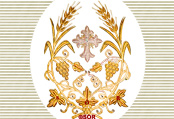
 |
|
||
| The Syrian Urhoyan Cuisine |
|
From the blessed city of Urhoy (Edessa) comes a collection of 124 savory and authentic recipies. The Urhoyan cuisine has been developed throughout centuries handed down from parents to children for generations. Fr. Joseph Tarzi learned these recipies from his mother, sister and other skillful Syrian Urhoyan cooks. Throughout their long history, and as a result of their interaction with numerous cultures and civilizations, the kafe (enjoyment) loving people of Urhoy have, with their refined taste, developed cuisine characterized by creativity, richness, enchantment, variety, colorfulness and good taste. Some varieties are rich and sophisticated. They are prepared specially for banquets and festivities. Others are simple and nutritious. They were invented by the Urhoyan people at times of hardships. These simple and inexpensive dishes served as sustenance during periods of distress and famine. Among the numerous varieties of Urhoyan foods there stand out few dishes that have been closely associated with Urhoyan Syrians. These include different varieties of kibbeh of which the raw kibbeh is the most famous. Equally famous are eggplant kabab and borani (chard with kibbeh balls). Despite similarity between some Urhoyan and other Middle Eastern dishes, particularly those common in the Levant (the Fertile Crescent), the Urhoyan dishes are prepared differently. Their ingredients impart a special flavor and distinct taste. Urhoyan foods are generally characterized as being hot, due to liberal use of hot pepper. Fresh and ground hot peppers are used in cooking and are also eaten with food. Urhoyans seldom use other hot spices as Indians do, for instance. Furthermore, Urhoy is the only city in all of Mesopotamia that consumed hot food. The fact that there existed trade between Urhoy and India may, nevertheless, explain this. The Syrian Urhoyan merchants are believed to have learned to eat hot food from their Indian brethren. The habit soon spread among all Urhoyans of different ethnicities. The author gives the historical background of this unique cuisine along with names in Syriac, Arabic, equivalents in English and known original names. The author devotes a chapter to the origin of the names of different dishes. Color photographs of 22 selected dishes are included. |
|
| Copyright © Syriac Orthodox Resources. All Rights Reserved. |
| Last Update:April 8, 1999 |